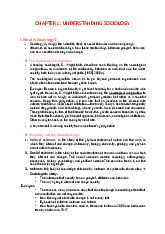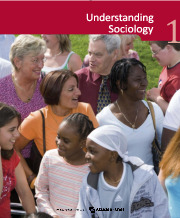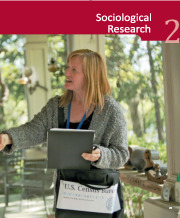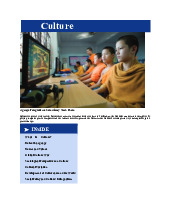




Preview text:
VIETNAM NATIONAL UNIVERSITY - HO CHI MINH CITY
INTRODUCTION TO SOCIOLOGY – FALL 2023 - 2024 GROUP ASSIGNMENT GROUP 13 Date: 23/10/2023 STUDENT'S NAME STUDENT'S ID Trần Ngọc Bảo Trân BAACIU21205 Lê Thị Khánh Huyền BABAIU21413 Trần Tuấn Khanh BAFNIU21305 Hoàng Diệu Linh BABAWE21538 Nguyễn Ngọc Phương Thư BABAWE21744
Chapter 1: Sociology (Group 10-14)
Q1. What and Why is social relationship important?. Propose an example to justify the
influence of social relationships on human behavior.
Q2. Students kindly choose one of examples of sociology (e.g., Tet holiday, Confucianism
in Vietnam, Sharia Laws in Muslim countries, Black lives matter), please explore deeper
understanding of sociological imagination by answering the following questions:
● Clarify it, What is it? How was it established?, etc.,
● Students are asked to clarify the impact of this case on human behavior. Solution: Q1.
A social relationship refers to the relationships and interactions that exist between people in
society. These relationships can take many different forms and occur on multiple levels,
ranging from intimate personal connections with family and friends to more distant exchanges
with acquaintances, coworkers, or even members of larger communities.Humans require social
ties, which play an important part in molding people's lives and well-being. They can provide
emotional support, information sharing, and collaboration in a variety of areas of life. Here are
some common social relationships: family relationships, friendships, romantic relationship,
community and social relationships, etc.
There are many reasons why social relationship important:
● Collaborations and Cooperations: Social relationships play a crucial role in
communities especially teamwork and collaboration in both personal and professional
settings. When they have high awareness of work and know how to efficiently
communicate, like solving problems with customers, partners, they are able to achieve common goals.
● Social Norm, Behavior and Social Control: Through the establishment of social
standards, expectations, and social control, social interactions have an impact on human
conduct. We frequently adapt to these norms in order to fit in or earn acceptance from
others, and the worry of facing social repercussions might deter unconventional behavior.
● Information and Learning: Social interactions facilitate the sharing of knowledge,
experiences, and cultural values. Learning from others is a significant part of human development.
● Sense of Belonging: Humans are naturally sociable creatures, and social connections
provide a sense of identity and belonging. Being a part of a group or community can
improve one's sense of self and worth. It can provide them a sense of direction and community.
● Emotional Well-being: Social relationships make them reduce stress and escape the
loneliness feeling and isolation. Communicating is the key point of social relationships
and helps people have higher energy when eliminating many difficulties in their life by communicating.
Example to Justify the Influence of Social Relationships on Human Behavior:
Social relationships with peers during adolescence play a significant role in shaping behavior.
Adolescents often seek acceptance and validation from their peer group, which can influence
their decisions and actions. For instance:
● Peer Pressure on Substance Use: Teens who hang out with friends who use drugs,
alcohol, or smoke may take up these harmful habits themselves in an attempt to fit in or
win the favor of others. This demonstrates how social interactions can influence actions
that may not be consistent with a person's principles.
● Academic Performance: Positively, social connections can influence academic
achievement as well. When a kid associates with peers who excel academically, they
may be more motivated to put in more effort and achieve better grades.
In general, this illustration demonstrates the profound influence that social relationships—
both positive and negative—can have on people's conduct. It emphasizes how crucial it is to
comprehend how social ties affect an individual's decisions and behaviors.
Q2. Example of sociology: Tet Holiday What is Tet Holiday ?
Tet is the most significant traditional holiday in Vietnam. It is often referred to as Tet Nguyen
Dan or simply Lunar New Year. The Vietnamese New Year is celebrated according to the lunar
calendar, and according to the Gregorian calendar, it usually occurs between late January and
mid-February. Vietnamese people celebrate the start of a new year and pay respect to their
predecessors during Tet, which ushers in the spring season.
How was it established ?
During the reigns of the Three Emperors and Five Emperors, the Lunar New Year, a component
of Chinese culture, first appeared. Based on their chosen colors, the kings selected various
months for the year, including January, December, and November. Different Tet days were
designated for various dynasties, with the idea of "creating heaven and earth" being used.
During the Eastern Zhou Dynasty, Confucius changed the month to the Tiger month, while Qin
Shi Huang changed the Pig month to October. Tet was instituted by Emperor Han Wu (140 BC)
of the Han Dynasty in the Tiger (January) month. No dynasty altered the Tet month again after then.
Vietnam's Tet holiday has a lengthy and complicated heritage that reaches over thousands of
years. It became a historical and agricultural event to celebrate the dawn of the new lunar year
and the coming of spring. Tet's origins are firmly ingrained in Vietnamese mythology, customs, and historical occasions.
● Agriculture-related value: it closely relates to the Vietnamese rice harvest cycle and
the agricultural calendar. It's an occasion to rejoice in the arrival of spring, which is
significant for farmers since it signals the start of the rice planting season. This is a time
of optimism and anticipation for a prosperous agricultural year.
● Historical background: Vietnamese society has long celebrated the lunar new year. It
is said to have been observed for a very long time, possibly even during the reign of the
mythical Hung Kings in Vietnamese history.
The impact of Tet’s holiday on human behavior:
Tet is the most traditional and popular festival in Vietnam because Tet’s holiday has a lot of
effects not only for mental values but also it is a good culture which should be developing. Tet
is deeply ingrained in the minds of Vietnamese people and is considered an indispensable holiday.
Some traditional behavior in Tet’s holiday:
● Worshiping the ancestors:It is also an occasion for pilgrims and family reunions.
During Tet, Vietnamese visit their relatives and temples, forgetting the troubles of the
past year and hoping for a better upcoming year. Tet’s holiday affects mental values for
Vietnamese people who know to do good things and to pay respect to their ancestors
and expect new years which have many successes and luckily.
Thanks to influences from culture and religion , Confucianism, Buddhism, and Daoism
have all been incorporated into the Tet festival over time. It involves paying homage to
one's ancestors, presenting sacrifices to gods, and going to pagodas and temples to seek spiritual guidance.
● Shopping behavior: People in Vietnam believe that if they wear new clothes
(traditional like Ao Dai or colorful bright colors like red, yellow or blue) on Tet
holiday, it can bring good luck and prosperity to people for the upcoming year. So, a
trend of shopping in Vietnam during the period before Tet became significantly popular
and important, almost all shopping streets in Vietnam (such as Tran Quang Khai,
Nguyen Trai,..) crowded and bustled.
Besides, people have planned to purchase beverages, confectionery, jam and gifts
around 1 or 2 weeks before welcoming Tet. Because in Vietnam beliefs, The jam tray
is first of all a wish for a happy and sweet new year that the homeowner gives to the
guest who comes to celebrate Tet at their house. This is also the homeowner's own wish
for good luck in the new year. In the jam tray, candy can not be missing, sweet candies
represent the expectation that the new year will contain many sweet things.
● The Events, Family and Local Customs: -
The events: During Tet’s holiday, there are some different things every year,
however, there are a lot of festivals to start the new year with lots of traditional activities
such as Spring Holiday, Flowers Markets,... Many people believed these events created
an interesting atmosphere for Tet’s holiday. Especially, Vietnamese people always have
local customers is that before Tet’s holiday who will prepare all of things to Tet’s
holiday so those event is a change to help Vietnamese easily to buy necessary things for Tet. -
Family reunions: Vietnamese people have a “first home” culture, so that during
Tet, they visit their hometowns and get together, watch fireworks and play cards with
their family. As a result, family ties are strengthened and a sense of community is
fostered. - Gift-Giving : Exchanging presents is customary during Tet. People show
their love and goodwill by giving presents and lucky money to friends, family, and
children. Giving gifts is a show of kindness and compassion. -
Spring cleaning, Decorating house : Cleaning the house is thought to help
banish any bad luck or unfavorable energy from the previous year. It's a chance to make
a clean slate for the new year. Additionally, it means welcoming good fortune: Good
fortune and wealth are often connected with a clean home. People can entice good
fortune and great energy into their houses for the upcoming year by cleaning up and clearing out clutter. -
Preparing traditional cuisine: A big part of the festival is preparing and
sharing special Tet delicacies like banh chung (sticky rice cakes), banh day and mut
(candied fruits). Cooking and consuming these foods is a way to maintain culinary customs.
● Travel behavior - a new trend: Many Vietnamese people, especially young people,
prefer traveling on the occasion of Tết (Lunar New Year) than staying at home or going
to a relative's house to wish a happy new year. They believe it is an opportunity to
release stress after a hard year, to begin a new year full of joy and excitement, and luck.
People frequently travel great distances to be with their loved ones during Tet, which
centers around family reunions. It helps to strengthen family relationships. Tet's holiday
is the most important festival in the year, so there are things you should not do during
Tet. Many people have a spirit not to fight during the Tet holiday, especially around
midnight on New Year’s Eve. because arguments could attract bad spirits into the house.
Others believed that you do not wear black or white. These colors are traditionally
reserved for funerals, and many think wearing these colors during the Tet holiday symbolizes bad luck.
Overall, the Tet celebration has a significant influence on how people behave in Vietnam,
encouraging the preservation of cultural traditions, bolstering social and familial ties, and
fostering a hopeful attitude on the future. Traditional values are respected during this period,
as people gather to celebrate their ancestry and anticipate a fresh start.




